Common Diseases & Conditions in Pets H-L
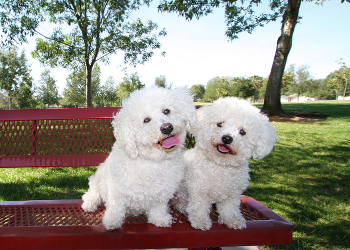
Hypertrophic Osteodystrophy is a debilitating disease seen most commonly in large breed, young dogs. It is characterized by a non-inflammatory bone growth or periosteal reaction in the metaphysis of long bones. It is seen commonly in Great Pyrenees, Great Danes and Newfoundlands.
In HOD, swelling and bone deposition cause widening of the metaphysis (This is sandwiched between the epiphyseal and diaphyseal part of the long bone). Periostitis may occur and this is extremely painful. The periosteum is the outer layer of the bone.
The most common sign seen associated with the disease is the development of bilateral lameness of the forelimbs with hot, painful swellings of the wrist joint. Dogs will usually run a high fever about 105.0F- 107.0F. They may have nausea, diarrhea and be dehydrated.
Radiographs of the affected joints are always taken. A CBC and Chemistry profile are performed to rule out systemic disease.
Diagnosis of HOD is made by historical findings plus the presentation of a young, large breed dog with bilateral lameness of the forelimbs with swellings around the wrist. Radiographs will confirm the diagnosis.
Many dogs may spontaneously clear or improve after several bouts of the condition. Any bone deformities will not correct on their own. Regardless, it is extremely painful. Most dogs are put on an appropriate dose of Rimadyl® a non-steroidal anti-inflammatory drug. If used frequently, the dogs liver enzymes need to be evaluated frequently. Some animals are put on antibiotics. It is crucial that the home environment be comfortable. A thick comfortable bed and protection from slippery tile or wood floors and stairs is recommended.
The prognosis for this disease varies with the individual and degree of inflammation and lameness that remains after the condition is resolved. Many animals get over it with only minor issues.



Idiopathic Thrombocytopenia (ITP) is a serious immune-mediated disease in the dog. It is caused by self produced auto antibodies against the bodies platelets. Platelets are needed in the coagulation process.
Platelets are crucial for primary hemostasis. They originate in the bone marrow from cells known as megakaryocytes. In the absence of platelets, severe internal bleeding can occur with skin bruising known as petequia or ecchymosis. Life can not continue without platelets. It is this lack of platelets that produce associated clinical signs.
Clinical signs associated with ITP are due to a decrease in active platelet numbers. Internal bleeding and signs can occur anywhere. Weakness & lethargy are commonly seen. Bleeding may be noticed in the oral cavity as well as blood passed in the feces. Animals bruise easily and that may be noticed over the animals body surface. Visible bleeding may also occur in the eyes.
A CBC and Chemistry profile are always performed. The platelet count is the most important piece of data. Normal dogs have a platelet count of about 225,000. Whenever that level reaches 20,000 bleeding will occur. Other conditions such as parasitic (babesiosis, heartworm and ehrlichiosis) can cause a secondary ITP. A tick born profile would than be recommended plus an occult heartworm test.
Diagnosis is made by the history and physical exam plus the presence of associated clinical signs. A diagnosis is confirmed by a platelet count of below 20,000.
Regardless of the cause of the ITP, almost all dogs will require a whole blood transfusion. This contains red cells and platelets. A low platelet count is life threatening. If the cause of the ITP is infectious, antibiotics will be given. If it is caused by a parasitic blood infection, the appropriate therapy is applied. If the ITP is immune-mediated, animals will be treated with corticosteroids and azothioprine. Other supportive measures such as intravenous fluids and feeding support are important.
Although ITP is a severe life threatening disease, the majority of dogs do well and lead normal happy lives. Those dogs that respond to therapy the quickest often have the best prognosis. The goal is to wean the animal off of all medications. In the case of infectious or parasitic causes, the platelet count should return to normal after appropriate primary treatment. Immune-mediated causes have a good prognosis also. An attempt is made to wean the animals off of corticosteroids and or azathioprine. Some dogs may relapse and require the same treatment. Prognosis for those animals is good as long as the owners are ultra vigilant about any changes in the dogs day to day life plus frequent medical visits for examination and multiple repeats of a CBC.



Inflammatory Bowel Disease (IBD) is often lumped into a host of different diseases. This presentation will attempt to put the issue into a more focal context. IBD is usually associated with an immune-mediated response to “something” in the body or digestive tract. That “something” might be a bacteria, virus, food allergy or parasite. The actual cause is unknown. It is a disease associated with the digestive system and is usually seen in middle to older dogs and cats.
IBD is a chronic disease process of the intestinal tract. The autoimmune reaction causes a thickening of the bowel mucosal tissues. This alters its absorptive and motility properties. This whole reaction is an intense local inflammatory response that disturbs the normal intestinal physiology. Clinical signs seen are all based on this precept.
The most common clinical signs noted are: the presence of loosely formed stools (even diarrhea), whole blood in the stool, associated weight loss and poor coat condition, fever, lethargy and tenesmus (straining to defecate).
A CBC and Chemistry profile are drawn to assess the animal’s body wellness. An inflammatory response may be noted on the CBC plus albumin may be low due to the digestive losses of it and other proteins. Radiographs utilizing contrast media, such as barium, or an ultrasound may show a thickening of the intestine in question. Fecal exams are done to rule out intestinal parasites. On a laparotomy, a biopsy of the intestine may be required for a definitive diagnosis.
Diagnosis can many times be difficult because strict IBD can mimic many other disease processes or causes of intestinal upset. A diagnosis can be at least tentative by historical findings in a middle aged or older dog or cat, clinical signs and supporting blood work and radiographs. An intestinal biopsy would be diagnostic. Most people do not go that far so one can many times only suspect IBD and treat it.
Treatment of IBD rests on trying to treat the primary cause and provide supportive care. The goal of any therapy is to allow the animal to gain weight. The immune-mediated situation is usually taken care of by corticosteroids. Many patients also benefit from the oral administration of budesonide; a non-systemic glucocorticoid that acts locally without any negative side effects elsewhere. Dogs are also put on numerous types of broad spectrum antibiotics to take care of bacterial overload. Good possibilities are fenbendazole (Panacur®) and metronidazole (Flagyl®). Sulfasalazine is often used if the clinical signs are in the colon. Dietary changes may help. Chicken and rice diets or facsimile or a hypoallergenic diet may be tried if a food allergy is suspect by blood testing. Carafate may be given to coat and protect the intestinal mucosal surface. Animals that are dehydrated will require fluids.
The prognosis for most patients is good but IBD can not be cured but only controlled and it is highly likely that there will be relapses at times in both dogs and cats. Over time, an individual will respond better to one therapeutic regimen over another. If there is a relapse and glucocorticoids have already been used, azathioprine (Imuran®) should be attempted in the dog but NEVER in cats due to toxic metabolites produced in a cats liver. This is due to the lack of an enzyme named gluconyl transferase.



The inguinal area of the dog or cat is the groin area. An inguinal hernia is one where abdominal contents pass through the inguinal ring and canal and become entrapped. Inguinal hernias can be congenital or acquired.
1. Congenital: This type of hernia is one that the animal is born with where genetics play a role. The majority of these are seen in young animals being vaccinated or examined for the first time. Most can occur on one side or the other and contain omentum (abdominal fat). These are uncomplicated hernias.
2. Acquired: This type of hernia is produced by blunt trauma, pregnancy or obesity. Many of these are complicated. Regardless of the cause of the acquired hernia, intestinal loops, uterine horns and other viscera can be entrapped in the inguinal hernia. This is a life threatening problem.
In an uncomplicated inguinal hernia, the only clinical sign is a small protrusion or swelling in the groin area on one or both sides of the body. In a complicated inguinal hernia, fever, inflammation and a painful groin area, vomiting and anorexia are seen.
In all cases of inguinal hernias, radiographs are taken to figure out what is enclosed or entrapped in the hernia. Intestinal loops are gas containing and easy to see. Many cases of uterine horn displacement are in dogs along with their pregnancy and visibly seen. The issue is how long the organs have been displaced. Often that is not known so a complete CBC and Chemistry are done to assess general body condition. An ultrasound may also be performed.
Diagnosis is made by the presence of a soft, fluctuant swelling over the inguinal area in dogs or cats. Deciding whether it is uncomplicated or complicated is determined on lab work performed.
Treatment is always surgical. It can be approached several ways. In uncomplicated hernias, an incision is made over the hernia and the contents (usually omentum) are pushed back into the abdomen and the hernia is closed. In complicated cases, it may also require a caudal mid line abdominal incision to pull the intestinal loops and or uterine body out of the hernia. Tissue than is assessed for viability. Many times, the intestinal loops are twisted and blood supply is curtailed. These require a resection and anastomosis (putting back together). Regardless of the inguinal hernia contents, it is CRUCIAL that the caudal part (posterior) of the ring NOT BE CLOSED. This is where the femoral vessels pass through to the hindlimbs. Doing so, will choke off arterial and return blood flow from the hindlimb to the heart via the caudal vena cava.
The prognosis for the majority of inguinal hernia repairs is excellent. The more complicated ones where the animal is septic or extremely ill from distended intestinal loops or uterine horns, have a more guarded prognosis until the effects of surgery and antibiotic therapy take hold.
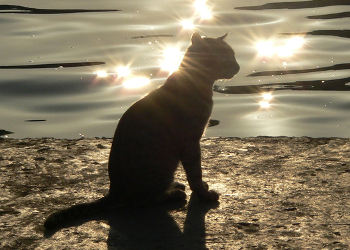


The spinal cord is a very protected piece of anatomy. Damage to it would impair normal body functioning. So that dogs and cats can have flexible movement of the spine there are spaces between the vertebrae that are filled with spongy cartilaginous material known as an intervertebral disk. If this disk degenerates over time or there is trauma that causes a protrusion of disk material away from its natural position (a disk hernia) clinical signs will develop.
In type 1, the actual outer layer of the disk can become extremely hard. Animals jump off of sofas and beds all the time. This force, over time, will allow the contents of the disk to prolapse onto the spinal cord.
In type 2, the entire disk becomes hard and as the animal ages it decomposes and prolapses into the spinal cord area.
In either case, this puts extreme pressure on the spinal nerve roots. Depending on where the prolapse occurs will determine the location and type of clinical signs seen. Disk disease is extremely common in Cocker Spaniels, Dachshunds, Miniature Schnauzers and Beagles. Obese animals are also more prone to disk disease than trim animals.
The most important clinical sign seen is excruciating pain over the spinal column in question and or nerve innervated areas. Animals may become lame or paralyzed if the disk protrusion is severe. There may be flaccid paralysis where the hindlimbs can not move and the musculature is limp or a spastic paralysis where the animal can not move in its hindquarters and the hindlegs are held in spastic extension under the animals abdomen.
In most animals there is referred pain. This is pain that is felt away from the site of the clinical lesion or trauma. An example would be an animal that has a lumbar disk protrusion. Just touching its abdomen will be excruciating painful.
Most animals will barely move. They try to position themselves so maximum weight is taken off of the injured disk area. They are incapable of getting into a comfortable sleeping position. Because they hurt so much, they will be off their food and many times find it too painful to get into a position to urinate or defectate. Dogs will also demonstrate kyphosis. This is an arching of the lumbar vertebrae that gives a hunched up look to the animal. I often showed a client a normal spine and than a radiograph of their pet showing the big difference in spinal curvature.
The most important thing to do is radiograph or ultrasound the animal. In some cases, the space between the verebrae is decreased suggesting a disk herniation. In other cases nothing is seen on a lateral or VD view. Specialists may perform a myelogram or MRI since the spinal cord can not be visualized on a straight radiograph.
A diagnosis is based on historical findings, neurologic exam, clinical signs and especially if the results of a myelogram are available. Breed association also is important to recognize.
The most important job to perform is alleviate the pressure of the herniated disk on the spinal nerve roots causing the clinical signs. The area must be decompressed rapidly otherwise permanent clinical signs such as lameness or paralysis will become permanent. In less severe cases this will mean medical management that includes the use of glucocorticoids that will decrease the inflammation over the spinal root area. In more severe cases, a laminectomy is surgically performed by a specialist that removes a part of the vertebral “roof” attempting to alleviate pressures. Sometimes, this does not work.
Regardless of treatment, it is crucial that obese animals lose weight or the animal can re-injure the area again, which is never good. Animals must be confined and not allowed to catch frisbees or other types of activity. Walks should be limited. If away from the home, animals should be confined in a room or put in a crate or cat carrier. If an animal wants to sit next to you on a sofa, do not pick the animal up by its elbows facing you!! This puts tremendous strain on the spine. Using both hands support the dogs chest and abdomen underneath and gently pick the animal up. Animals will often not eat because it hurts too much to get into an eating position (prehension). Always elevate food and water bowls with a stack of newspapers or books so the animal can walk up to the bowls without having to stoop down.
Animals that are completely paralyzed may have a satisfying life if fitted with a special mobile cart on wheels that is strapped to the animals body. I have used such devices and it is great to see an animal not think about going over a curb with the device on. A recommended supplier of carts and other support products is K9 Carts.
The prognosis for intervertebral disk disease is guarded in almost all cases. Yes, clinically they may do well after treatment and lose weight at the same time. However, no back or disk issue is ever 100% cured. It can cause disease again in the future. A big part of preventing re-injury is by following instructions written in the treatment block. Prognosis is also extremely guarded in those animals that are urinary or fecal incontinent. They will have to be supported to go outside to urinate or defecate.
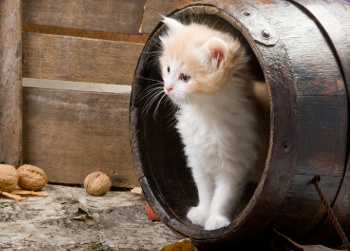


The gastrointestinal tract is composed of: oral cavity, esophagus, stomach, small intestine and large intestine (colon) plus rectum. Its main function is intake of food, processing or digesting that food and eliminating waste product in the feces. Animals get into trouble by swallowing foreign objects that do not belong there. The variety of objects swallowed is limitless. Watches, coins, batteries, sticks, needles, ear plugs, pantyhose, thread or yarn, underwear, mulch and the list goes on and on. Cats of all ages are fascinated by anything that is linear in shape. This includes string or yarn and Christmas tree wrappings. Cats also love swallowing anything that shines. So back to Christmas trees and other objects like rings. I used to tell clients with cats and or young children to hang their Christmas tree upside down from the ceiling. That is how bad it gets!
I once had a client that had enjoyed celebrating a child’s birthday with cake and balloons. Later that day, the animal was presented with the balloon string swallowed and the inflated balloon hanging out of its mouth! The string ended up being lodged in the small intestine, requiring surgery.
Depending on what type of object and where it is located dictates what happens to the animal. The most dangerous items are those that are sharp and or have sharp edges to them. They can cause intestinal bleeding and perforation of the intestinal tract which than leads to peritonitis. String or any linear object gets caught in the small intestine causing illeus. This means total intestinal stoppage. No intestinal peristalsis. The intestinal tract is bunched up like an accordion. Swallowing coins can lead to lead poisoning. Swallowing mulch or pantyhose can easily lead to a intestinal obstruction. Learn more about Linear Foreign Bodies. A set of industrial grade foam ear protectors fits just perfectly in the lumen (opening) of a cats intestinal tract causing a bowel obstruction.
Clinical signs are associated with the type of foreign body and where it is lodged. Objects in the mouth may present with bleeding and reluctance to open the mouth. Common causes are needles stuck in the throat and in big dogs, a length of stick perfectly stuck in the mouth between the upper molars of both sides of the mouth. Animals will also paw at their face thinking they can dislodge the foreign body. Objects in the esophagus will produce a retching and extension of the neck. This is dangerous because the esophagus is one huge muscle and anything foreign (like a fish hook) can easily get embedded more by peristaltic contractions of the esophagus. Objects in the stomach may cause an animal to vomit and in many dogs, no clinical signs! Objects in the intestinal tract may pass, if the dog or cat is lucky. I had a client whose dog swallowed the woman’s wedding ring. Every stool was sorted through and it was passed! You could see it on radiographs passing through the GI tract! Animals that have perforated bowels will be presented in an extreme shape of sepsis and or shock. These animals are extremely ill from bacterial overload in the abdomen (peritonitis). This is an emergency situation. There may also be bloody diarrhea if the intestinal mucosa is damaged.
If a foreign body has been swallowed, it is important to have a minimal database and that means a CBC and Chemistry profile. White cell counts are crucial to check for infections caused by the foreign body. Radiographs, contrast studies, ultrasounds and the like are important for imaging a potential foreign body.
Diagnosis is made much easier if the client just saw an animal ingest or swallow a foreign body. A phone call to the veterinarian may be all that is needed. Just by using hydrogen peroxide to induce vomiting may be all that is needed. Most times people do not see the animal ingest the foreign body. It is than diagnosed via imaging devices or a good physical exam such as looking in the mouth, roof of the mouth and so on. Many times a foreign body can not be diagnosed. Suspected but one can not prove it. In those cases a call is made to do an exploratory laparotomy to find the offending foreign body. Some are radiolucent and can not be picked up via standard radiography.
Treatment depends upon what type of foreign body and where it is lodged. Foreign bodies in the mouth are removed with forcepts. Items in the esophagus and stomach are usually reached with an endoscope. Items in the intestinal tract may be allowed to pass (usually while hospitalized). Those that are identified as sharp may be removed by an enterotomy (intestinal incision). Some objects that are sharp and small may be treated medically by getting the animal to swallow a wad of cotton soaked in beef broth. Usually, the cotton catches up to the foreign body, envelops it and it is passed in the feces. A rupture of the intestinal tract is repaired or the section is removed and put back together (intestinal anastomosis). Perititonitis is treated with antibiotics, peritoneal lavage and by a peritoneal drain put in for post surgical lavage. The abdominal contents go through a culture and sensitivity to provide the most effect antibiotic combination possible; as peritonitis can be fatal if not aggressively treated.
The prognosis for most foreign body removals is excellent if recognized and treated early. Animals that develop peritonitis are at a greater clinical risk and have a much more guarded prognosis until the peritonitis is treated with antibiotics and lavages. When the animal is feeling better and radiographs are rid of the typical abdominal ground glass appearance, the animal is on its way to recovery.



Kennel Cough is a severe respiratory disease in dogs. It is caused by numerous pathogens but the most commonly diagnosed is caused by Bordetella bronchiseptica. Parainfluenza is a viral cause of the disease and usually produces mild respiratory disease in dogs. Kennel cough also goes under the name of tracheobronchitis.
Bordetella bronchiseptica is a gram negative bacterial organism that infects mainly young dogs or those that are immune compromised. It is commonly seen in areas where animals are housed in close quarters or in direct contact with one another. Examples are pet stores or shelters. Both Bordetella bronchiseptica and parainfluenza are both transmitted to animals via nasal droplets or respiratory secretions. Viruses can be transmitted on dust particles. These are called fomites.
Clinical signs are always respiratory in nature. Animals are anorexic, febrile and present with a hacky cough that sounds like a goose! Many have eye secretions associated with conjunctivitis in both eyes. They have difficulty breathing and many are presented with open mouth breathing or their forelimbs abducted making it easier to get air into their chest. Some dogs have mild signs while others will be presented with bronchopneumonia with the entire bronchi and lung fields congested.
Chest films are always performed initially and every day (to assess treatment) to check the severity of signs in the respiratory tract. A CBC and Chemistry profile are drawn to assess white cell count and organ integrity. The organisms can be cultured and isolated, if desired.
Diagnosis is made most of the time in a young animal from crowded conditions with associated clinical signs and or absence of parainfluenza or Bordetella vaccination. Culturing the agent can also be diagnostic but most veterinarians base their diagnosis on the above. Radiographs help instruct on the extent of the disease.
Treatment is based on the severity of clinical signs. Many puppies start out with a mild cough or runny eyes. These animals are usually treated with Clavamox® and Hycodan® syrup for cough. Nebulization is recommended at home. Many of these animals resolve but others get worse and need to be hospitalized. This entails: intravenous fluids and feeding, nebulization 4-5 times per day, treatment of the conjunctivitis with topical ophthalmic antibiotics and radiographs every day for clinical assessment. Clavamox® and or Baytril® are usually the antibiotics of choice whether used separately or together for maximum bacteriocidal coverage. Severe cough is controlled via parenteral butorphanol. The latter also eases a lot of the chest pain associated with acute cough. Once animals are breathing better with a clear lung field plus eating and drinking on their own, they are sent home on antibiotics, nebulizing supplies plus high caloric diets such as Hill’s® Prescription a/d.
The prognosis for the vast majority of clinical cases of kennel cough are quite good. Tiny breeds such as Pomeranians or Toy Poodles with pneumonia are at a much greater risk due to their tiny lung fields.
Kennel Cough really weakens an animal’s immune system. Vaccination is important but the animal has to be built up first, otherwise the vaccine can do more harm than good. All healthy animals should be placed back on a puppy vaccination program. This program also includes vaccination for the common causes of kennel cough: parainfluenza and Bordetella bronchiseptica.
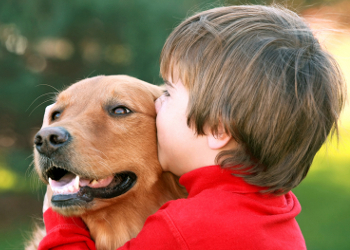


Keratoconjunctivitis sicca also goes by the name of “dry eye”. Tears are extremely important for eye functioning. They clear the corneal surface of dust, debris and mucous plus also lubricates the eye and surrounding tissues to minimize friction when the eyelids blink or the third eyelid rises. A deficiency in tear production in older animals is the most common cause of kerititis sicca in the dog. Tear production decreases can be often congenital or immune mediated. Medical induced KCS can be caused by the excision of the nicatating gland (cherry eye). Other causes can be eye irritants.
When tear production decreases, lubrication of surrounding ocular tissues is affected; particularly the cornea. The cornea can dry out and blinking can cause excessive friction and irritation. Vessels in the white of the eye (sclera) are inflamed as well as the subconjunctival tissues. Breed predisposition is always at play. This condition is seen commonly in Pugs, Pekingese, English Bulldogs or any other breed with an exopthalmic (protruding) eye structure.
The most commonly seen signs are: squinting of the eye, inflamed conjunctiva and vessels of the sclera, elevated third eyelid, presence of yellow, greenish mucous over the cornea and often the animal will paw at its eye trying to relieve the irritation. Severe cases can lead to corneal ulcers with possible loss of vision in the affected eye.
The most important test to perform is the Schirmer Tear Test. This is a dye impregnated strip that is inserted in the lower conjunctival sac that will monitor tear production. Normal readings in the dog or cat are about 18-20. Severe KCS produces reading in the 3-5 range and intermediate cases in the 8-16 range.
It is extremely important that the animal be screened for glaucoma at the same time by the use of a tonometer. Many dogs will have both dry eye and glaucoma presented at the same time!
Diagnosis is made by historical findings plus a complete physical examen. A Schirmer Tear Strip confirms the diagnosis. Clinical signs also lead towards a tentative diagnosis.
KCS can be present in one eye or both eyes at the same time. This is why both eyes are checked even though only one eye may be showing clinical signs. The other may be normal or a bit behind the other eye in clinical signs. Most treatments start with tear supplementation done 2-3 times per day. The patient is than reevaluated via a Schirmer Tear Test strip. If tear production has not been bumped up into normal ranges, 1% or 2% Cyclosporine drops are prescribed. Cyclosporine is an immuno-suppressant drug used in transplants and skin conditions but when applied to the eye, will stimulate tear production. Once Schirmer strips are normal, medication is continued life long with periodic Schirmer Tear tests performed.
If a corneal ulcer is diagnosed via a fluoroscein stain, the ulcer must be treated with appropriate antibiotics and restained in two weeks to check for corneal healing. All corneal ulcers heal from the outside in.
As long as there is no vision loss from an untreated corneal ulcer, most cases of KCS respond extremely well to medical care. It can not be cured but controlled with medical care.
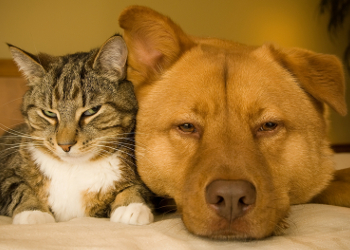


The kidneys are extremely important for mammalian life. Their main function is to secrete urine which contains waste products (mainly urea) dissolved in water. They also regulate sodium and water re-absorption (via ADH). Urine is than passed through the ureters to the urinary bladder for storage. When the micturition (urinating) urge arrives, the urine is voided to the outside. Anything that upsets the apple cart will cause signs of renal disease. Renal disease can be broken down into: pre-renal, renal and post-renal. Causes of renal failure are many. Congenital, amyloidosis, bacterial, viral, toxins (anti-freeze), secondary to heart or liver failure are just a few of the causes. Renal failure can be acute or chronic.
The kidneys depend upon a consistent and reliable blood flow to and through the organ. This flow goes by the name of the Glomerular Filtration Rate (GFR). When it is interrupted, problems arise:
1. Pre-Renal Failure: In this type there is a clinical disease before the kidneys. This often includes heart, liver or circulatory issues. Insufficient waste products are delivered to the kidney producing signs of kidney disease.
2. Renal Failure: This is when the anatomy and or physiology of the kidney is altered. This prevents the normal production of urine leading to signs of kidney failure.
3. Post-Renal Failure: This type of failure is always below the kidneys and is produced by some obstructive disease of the lower urinary tract; either in the ureters, bladder or urethra.
In acute renal failure, damage to the kidneys is often minimal and will improve rapidly with appropriate medical care. Dogs or cats with chronic renal failure are usually suffering from parenchymal damage to the kidney itself. It barely functions. Acute failure dogs will produce very little urine initially. This is a survival response. In chronic failure the animals drinks excessive amounts of water and since kidney function is basically non-existent, produces urine concentration just a step above straight water.
Animals with renal failure are sick and I mean sick. They all have elevated Blood Urea levels. Urea is a depressant of the Central Nervous System (brain). Animals are sluggish, vomiting a yellow bile and have a characteristic halotosis associated with their renal failure. They rarely have an appetite. Animals may drink more water and urinate more. There may be blood in the urine. In severe cases, animals will be presented completely recumbent with typical Kussmaul respiration; deep and labored. These animals are extremely ill.
The most important tests are the CBC and Chemistry profile. Renal patients may be anemic since the kidneys are unable to produce the hormone, erythropoietin. This hormone stimulates the bone marrow to start manufacturing red cell precursors. The chemistry will show electrolyte imbalances (sodium and potassium), elevated phosphate levels PLUS an elevation in the BUN and Creatinine. Those tests determine renal function but the creatinine is the most important. BUN can vary even in normal individuals. Animals fed a low protein diet will have a low BUN. Regardless, these tests will be elevated when there is about 75% of renal tissue that is failing so therapy must be aggressive to save lives. A urinalysis is important. It will usually show a more dilute urine (normal is 1.025-1.030). Urine strips will show high protein concentrate in the urine. An ultrasound may be performed to visualize the form and structure of the kidneys. A Urine Protein Creatinine Ratio (UPC) is important. It will show if the animal is showing signs of glomerulonephritis. The glomerulous is like a drain in a kitchen sink. If debris is clogging the drain, water will not pass and will back up in the sink. This is exactly what happens in glomerulonephritis which makes renal failure even worse. In immune-mediated cases, antigen/antibody complexes “clog the drain”.
A diagnosis of renal failure is made by a complete physical exam, history of clinical signs and particularly from the CBC and Chemistry profile. Diagnostic imaging may also suggest renal failure.
Treatment of renal disease depends upon the type of renal failure and whether it is acute or chronic. Many of these therapies will overlap in many circumstances. The most important treatment is trying to get the renal tissue functioning again, making sure obstructions are relieved plus eliminating as much urea waste as fast as possible. This involves intravenous fluids that are run at a relatively high rate without fluids backing up in the lungs. Diuretics such as furosemide are given intravenously to produce more urine and out through a urinary catheter placed earlier. Input/Output can be calculated by measure fluids in and fluids (urine) out. Nutritional feeding can be performed by a esophageal or stomach tube. All of these animals are vomiting and can not keep food down. They need combinations of Cerenia® with famotidine to keep vomiting under control. Urea not only depresses the CNS but is an extreme irritant of the mucosal lining of the intestinal tract. If there is no vomiting, the animal can be given carafate liquid or tablets orally. Phosphate levels are quite high so phosphate binders such as Aluminum Hydroxide are administered via a tube or orally when the animal can keep basic foods down. In acute failure dogs, animals respond reasonably quick. When they are not vomiting, a bland diet is attempted such as chicken and rice or Hill’s® Prescription Canine k/d. To make these diets more palatable; sprinkling them with some Nutrical® or tuna juice will make it more palatable.
Many dogs with chronic renal failure will need off and on fluid support as well as phosphate binders and periodic injections of erythropoietin for bone marrow red cell precursors. These dogs drink a lot and urinate a lot so a large bowl of fresh water should always be present.
Most pre-renal failures are treated the way mentioned above. If there is concurrent heart or liver issues, those must also be addressed. In cases of post-renal failure, the obstruction has to be relieved surgical or medically so that there is no impediment of the flow of urine to the outside. In renal failure, what to do with the injured kidney varies with the cause. With renal amyloid, the entire renal architecture is one big glob of muck. Surgical excision is recommended. In pyelonephritis the above therapy plus intravenous antibiotics may work. In renal abscesses, an exterior drain or surgical removal may be necessary. When one kidney is removed leaving a healthy one, this is a classical case of normal hypertrophy. The remaining kidney enlarges taking on the physiological function of two. That is why all mammals can live with just one functioning kidney. Many of these animals will also undergo dialysis or abdominal lavage and drainage to control levels of urea.
The prognosis for rapidly treated straight acute renal failure is very good be it pre-renal or post-renal. The prognosis for renal failure due to tissue damage varies with the cause and treatment selected. Chronic renal failure has a overall long term poor prognosis. The animal becomes more debilitated over time with worsening renal functioning. There comes a time when medical therapy does not work anymore.
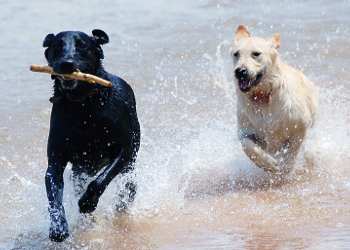


A laceration is a tear in any tissue. It can be of any length but what differentiates a laceration from an incision is that the latter is a smooth, delineated cut produced in tissue by a scalpel or laser beam. Lacerations may be jagged, irregular and involve multiple layers of tissue. Some are superficial and some are deep. Lacerations can be caused by: car accidents, stepping on sharp objects like glass or metal, animal bites, getting hung up on chain link fence (yes, I did treat one), getting caught in a metal trap, cats getting caught in fanbelts and so on. The causes are limitless and each wound is different.
When a laceration occurs, immediate cellular and tissue damage is done. Tearing of tissue causes the beginning of cellular death and decay. The skin is the largest organ in the body and one of its prime functions is to keep nasty pathogens from entering the body surface. The skin protects everything inside of it! If that barrier is broken, bacteria are allowed to proliferate causing a wound infection. Nothing can heal properly while there is infection. If this infection continues it may penetrate into deeper tissues; causing organ involvement in one way but also in another, by entering the blood stream. Bacteria than are free to travel anywhere in the body setting up multiple infection sites. With associated toxin production, this is called sepsis. All lacerations should be taken seriously; even if they are only half an inch in length.
The clinical signs of laceration presentation are as varied as the causes. They can occur anywhere on the body surface. They may be as long as the animal itself or only an inch long. Some have a jagged edge or a “V” type appearance; which is caused by a tear and the animal running away at the same time. Underlying tissue may be damaged, mainly the subcutaneous and muscle layers. Some lacerations will actually penetrate the adominal or thoracic cavities. The latter will cause the lungs to collapse since the thorax is under negative pressure. At a minimum, penetration of the thorax will cause a pneumothorax (air in the chest cavity). Dogs and cats will be in severe pain and will be limping if the lesion is on a limb. If infection has set in, many will be off their normal diets and be lethargic.
All laceration patients should have a CBC and Chemistry profile performed. The white cell count may be elevated if the patient wound is infected. If there has been blood loss, the red cell count will be lower. The chemistry profile provides an overview of general body functions. Other tests may be required depending upon the location of the injury. Chest and abdominal injuries require radiographs or an ultrasound performed.
Diagnosis is made on physical exam. Knowing the cause of the laceration makes it easier to understand what happened. Many times clients just see the injured animal without noticing what caused the damage in the first place. I got asked that all the time and my answer was often just speculative. In those moments, I wish pets could talk! Further tissue damage is best discovered or figured out when the animal is anesthetized and the wound can fully be explored.
The treatment of the wound depends upon the length and the severity of the laceration. A small half inch clean lesion will probably just be dabbed with a bit of surgical glue, wrapped and the animal placed on antibiotics for 2 weeks. The majority of lacerations require surgical care. If the lesion is small and the patient is able to be quiet, a local anesthetic is infiltrated and the wound is cleaned and stitched up. Many lacerations require surgical care under a general anesthetic or sedative. Wounds are first debribed. This means, that as much dead tissue is cut away providing a base for granulation (wound healing). If the wound is just superficial, the lesion is just stitched up. If their is damage underneath the skin lesion, it is repaired with multiple layers of sutures and a drain is placed to prevent formation of seromas (serum pockets that occur after trauma and form in “dead” space). There are lacerations that can not be closed by primary retention (skin to skin). Some have to fill in with scar tissue (third degree healing) and others can be brought together bit by bit over time (second degree healing). There are other flap techniques done by surgeons to close wounds on extremities. The goal is to provide as good an environment for healing to begin.
Wounds are than wrapped and the animal is placed on antibiotics for two weeks and anti-inflammatory drugs for about a week to control swelling. Some animals require analgesics such as Tramadol®. Most sutures are removed in about two weeks. Scar tissue does not have any hair follicles on it. If there is a scar that is usually not a problem in animals. Hair around the wound often covers or overlaps the scar area so it is not as noticeable.
The prognosis for almost all laceration repairs is excellent if diagnosed and treated promptly. If there are underlying problems such trauma to the abdominal or thoracic cavities, prognosis depends upon the resolution of those issues.
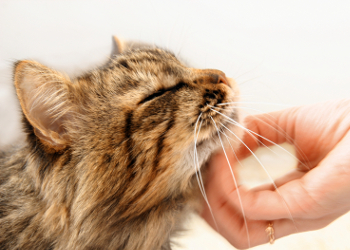


The larynx (voice box) is just the beginning of the respiratory or airway system in the body. It opens up when air comes in and relaxes when carbon dioxide is expired. It allows air to pass to and from the lungs. It also protects against food entering the lungs. Each time an animal swallows, the epiglottis (primary opening valve of the voice box) closes inhibiting the passage of food or water into the lungs. There is one big problem and this is why animals and people often choke. In mammals the beginning of the airways (nostrils) is at the top and slides to the bottom. The beginning of the digestive system (mouth) is at the bottom and slides to the top. When these two cross, it forms the pharyngeal isthmus. At that point food and water can go in either direction. If that direction is the respiratory tract, coughing begins.
Laryngeal Paralysis can be either genetic or acquired. I have seen genetic laryngeal paralysis in Doberman Pinscher dogs over the years. It is usually seen in young animals. Acquired laryngeal paralysis is often associated with excessive heat or stress and is seen most commonly in giant breeds of dogs such as Newfoundlands and St. Bernards.
In dogs with either type of larnygeal paralysis, the muscles causing the larynx to open during inspiration fail to function properly. Instead of opening the larynx, the walls of the larynx are sucked into the lumen of the airway causing a partial or total obstruction to airflow.
Clinical signs noted are panting and a different sounding bark. The most common sign is a whistling like sound on respiratory inspiration due to a narrowing (stenosis) of the laryngeal opening. Expiration may produce a rattling like sound.
A CBC and Chemistry profile are performed to assess the animal’s condition. An ultrasound of the larynx may be performed as well as an examination of the organ under a sedative.
Diagnosis is made by the association of clinical signs in a large breed dog. The history in these cases is probably the most important. It is crucial to understand what set off the laryngeal attack in the first place. Was it heat related? Did the dog just finish romping in the yard? All those are give aways. If signs are noticed in young animals a genetic base of the disease is suggested. Exams of the larynx also help in the diagnosis.
Initial treatment of laryngeal paralysis involves calming and or cooling the animal to decrease oxygen demand. Oxygen is given to the animal and some have to be sedated and intubated to provide oxygen to the lung tissues. There are surgical procedures performed by board certified surgeons that open one side of the larynx with stay sutures to make it easier for air to enter and leave the larynx. As with any laryngeal issue, dog owners should use a harness to walk the animal rather than a collar. The collar will irritate that anatomical area and make breathing more difficult.
With the current level of medical technology, the majority of animals live a quality life; particularly after surgery. Oxygen is the basis of life along with water. Animals that have their laryngeal opening increased are going to breath better. Breathing better means more oxygen reaching tissues making the animal feel much better. Dogs are also more active. The only issues with surgery are those cases where the suture line breaks down or with occasional cases of inspiration pneumonia. Those are usually treated successfully.
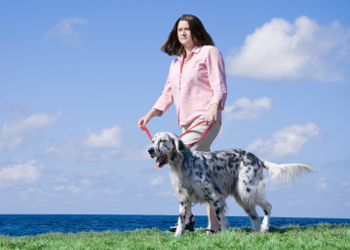


Laryngitis is defined as inflammation of the larynx. This is commonly known as the voice box and serves as a conduit for air entering and leaving the lungs plus preventing inhaled food and water into the lungs.
Laryngitis is often secondary to a respiratory infection. It can also be caused by the inhalation of toxic fumes and smoke. Trauma to the area can cause laryngitis. Improper removal of endotracheal tubes after a surgical procedure can also cause the problem.
Laryngitis is the most severe in bracheocephalic dogs that have a short tortuous sinus cavity and a scrunched up flat head like an English Bulldog. With any cause of laryngitis, the mucosal tissues lining the larynx become reddened, thickened and inflamed. This leads to the production of mucous. In severe cases, it can actually inhibit air from entering the lungs or at the least, a stenosis (narrowing) of the larynx.
The most commonly seen signs associated with laryngitis in the dog or cat is a dry, hacky cough. Some animals may regurgitate some mucous or phlegm. Dogs may have have a weird sounding bark. This is seen all the time with cats where they squeak like a mouse.
A CBC and Chemistry Profile are performed in most cases to check the white cell count and organ functions. Endoscopy is performed in severe cases to visualize the anatomy of the larynx.
A diagnosis of laryngitis is made on history and a physical exam. Just touching the laryngeal area will elicit a severe cough in most animals. Clinical signs and lab work will guide the veterinarian to a diagnosis.
Treatment varies with the severity and causal agent. If it is secondary to a bacterial or viral infection, antibiotics, cough suppressants and nebulization will be provided. That will take care of not only the primary cause but the associated laryngitis. Animals are than put on a soft diet that is easy to swallow such as warmed up chicken and rice. In more severe cases, diuretics may be given to dry out the laryngeal area making it easier to breathe. Some animals warrant corticosteroids when a strong anti-inflammatory effect is needed. In extreme cases where the larynx is closed a tracheostomy tube is inserted in the trachea just distal to the larynx. As with any laryngeal disease, a harness should be used instead of a collar when walking the animal.
The prognosis for most basic cases of laryngitis is excellent. If there are complications such as laryngeal stenosis or collapse, the prognosis is guarded until the airway issues are resolved.



Leptospirosis is a disease caused by a bacterial spirochete that lives in areas with high rainfall and in the soil. The most common pathogens causing the disease in dogs are: Leptospira grippotyphosa and Leptospira pomona. It is seen in dogs throughout the world but rarely seen in cats. It is a zoonotic disease, meaning there is a possibility of it being transmitted to humans. A spirochete looks like a corkscrew. Another disease causing spirochete is the one causing syphilis in humans; Treponema pallidum.
Dogs that hunt and or spend the majority of their time outdoors are at a higher risk of getting leptospirosis. The corkscrew shaped organism penetrates a scrape, cut or any other mucosal surface and reproduces in the kidney, nervous system and liver. Where the infection goes from there, depends upon the animal’s individual immune system. In many cases the animal self resolves by producing antibodies to the spirochete hence eliminating it from the blood. If the liver is affected it can produce several hepatitis. If the animal clears the bacteria, it can be a dangerous carrier of the disease. Even though the fever and infection have cleared, the leptospira organism can still reproduce in the kidneys and be passed in the urine to another susceptible animal (dog).
Leptospirosis has a wide variety of clinical signs that can be associated with many diseases in the dog. Fever, anorexia, lameness, weakness, hematuria, vomiting, diarrhea and depression can be seen amongst others.
A CBC and Chemistry profile are ordered since many body systems can be damaged by the organism. A fluorescent antibody urine test is the lab test usually used to diagnose the disease.
If a veterinarian suspects leptospirosis in your pet, it is extremely important that he and or other veterinary personnel are protected from coming into contact with ANY secretion and that means: urine, feces, vomit or diarrhea. All exams are performed with gloves. A diagnosis is made by obtaining a history of a dog exposed to the outdoors on a regular basis. A little Maltese sitting on a couch all day is not going to get leptospirosis. Clinical signs plus a positive titer to leptospirosis is diagnostic of the disease.
Animals that are severely ill are hospitalized and given intravenous fluids and other supportive care. Dogs that are not severely ill are put on antibiotics for a minimum of 4-8 weeks. The most commonly used antibiotics to treat leptospirosis are the quinolones: Baytril® or Zeniquin®. As long as there is no major organ involvement, most animals do well.
Prevention is the best bet. Vaccination has been available for the most common causes (strains) of leptospirosis for years. They are combined with other vaccines such as distemper or adenovirus or administered separately on a case by case basis. All large dogs, hunting dogs or others that spend a lot of time in the outdoors should be vaccinated and boostered in a year, if an adult. If it is a puppy, the animal is vaccinated for it monthly until a minimum age of 16 weeks has been reached; than vaccinated annually. Even if a dog is vaccinated, keep it away from areas of standing water and wash your hands as a preventative. Never come in contact with an animal’s urine.
The prognosis for most cases of leptospirosis is very good as long as there is no major organ involvement. The dangerous part of this disease is the presence of untreated dogs that are carriers of the spirochete. They can cause massive infections in susceptible animals that have not been vaccinated or those with a compromised immune system.
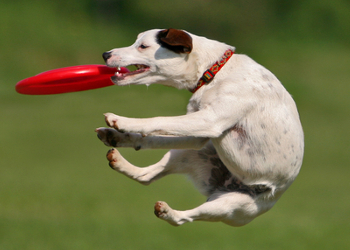


Lick granulomas may seem to be a simple thing to treat but they are not. A lick granuloma is composed of scar tissue. This is what a granuloma is. It is a condition that produces scar tissue that is exacerbated by licking the area. Suspected causes of lick granuloma are boredom, a persistent itch or separation anxiety produced by whatever stimuli.
A lick granuloma starts out as a small sore. If the animal would leave it alone, it would heal in two seconds! It does not! Instead of healing in a primary way, it is never allowed to heal correctly due to the constant licking of the lesion. This produces scar tissue that is extremely THICK. It is always seen over the wrist joint of the animal on either forelimb or over the hock (tarsus) of the hindlimbs. They seem to appear figuratively and literally overnight.
Clinical signs seen are the rapid presentation of a circular or oblong, inflamed lesion over the wrist or hock joint of the dog. It is usually moist due to the constant licking of the lesion by the animal. It is a psychological issue with the dog but it drives clients nuts particularly if the animal sleeps in bed with the owners. All they hear all night is….slurp, slurp, slurp. These lesions can become infected.
Most dogs with lick granulomas are not really sick. If the lesion is infected a CBC may be drawn to check the white cell count.
Diagnosis of a lick granuloma is by the presentation of a dog with characteristic lesions over the hock or wrist joint that suddenly appeared.
Over the years, I have heard of and tried many remedies to beat lick granulomas. I have tried injecting corticosteroids around the lesion. That helps a bit but does not get rid of the lesion. Owners have applied a sock and held it up with duct tape. The dog chews off the sock. Tabasco sauce, bitter apple, bitter orange have been applied with no luck. Dogs actually love the taste of tabasco sauce. Some owners, in jest, want the veterinarian to place the dog in a complete body cast. The best way to treat these lesions, from my own experience, is using laser surgery. This is called surgical ablation of the tissue. With the laser in hand, the doctor goes back and forth, back and forth over the entire lick granuloma over and over. The goal of this is to reach the nidus or irritating tissue way below the skin surface. It heals well and the dog stops licking. If the psychological issue is not resolved, the granuloma can pop up somewhere else in a month or so.
The prognosis for lick granulomas treated with laser surgery is quite good but they can occur elsewhere. Treating dogs with old remedies sometimes work. I feel those worked not because of the treatment employed but the psychological status of the dog improved. Improvement means it leaves the lesion alone to heal by itself.



The function of the digestive tract is to process food for nutritional support and rid the body of the digestive wastes. Dogs and cats love to ingest things that can play havoc in their digestive systems. Linear foreign bodies are those that basically form a line when the dots are connected. Examples are: string, yarn, tinsel from a Christmas tree, an electrical cord and thread are common examples.
When an animal swallows a linear foreign body, several things can happen. If the object swallowed is an irritant, it may make the animal regurgitate it up from the stomach or esophagus. Some cases that even make it down to the small intestine may actually pass in the feces if the object is balled up. Problems arise when it does not. The linear foreign body tries to snake through the small lumen of the small intestine. As this occurs, the intestine continues to work by its normal parastaltic motility. As this happens over and over the small intestine starts to look like an accordion and is literally all bunched up. Intestinal function can not continue and the normal functions stop. This is bad and is called ileus. When that happens, things stagnate and the blood supply to the area decreases. The intestine than sets up a bacterial infection with intestinal necrosis being the end result.
Clinical signs seen vary with the type of material and where it is lodged. Some animals may regurgitate up the offending material right in front of the owners or veterinarian. An object in the intestines leads to anorexia, vomiting and very little stool produced since digestive processes have come to a halt. In severe cases the animal runs a fever and becomes lethargic due to ileus. Sometimes the string cuts through the intestinal tract producing signs suggestive of peritonitis; characteristic radiograph “ground glass” appearance and extreme abdominal pain.
Cats are fascinating creatures but have an affinity and absolute attraction to linear foreign bodies. I have always asked clients if they sew or knit sweaters! If so, I have asked them to make sure the cat is kept out of the room to prevent not only yarn or thread from being swallowed but also preventing needles from being snarfed down by the creature.
Sometimes, the diagnosis is obvious. Such was the case when a small dog was presented with a balloon hanging out of its mouth by its string. That day, the owners held a birthday party for their young child. Surgery had to be done on that case. Cats are different from dogs. I made it a point in all vomiting cats to look at the base of the tongue (frenulum). If you are lucky, you may find string wrapped around there if the patient is cooperative. In most cases the string is already lodged in the intestines. The string is cut at the tongue base and removed through a gastrotomy or enterotomy.
Many animals presented with linear foreign bodies are ill; either from digestive signs or dehydration and electrolyte deficiencies. A CBC and Chemistry profile are done to assess those situations. It is very difficult to see a linear foreign body on radiographs since they are so small and narrow or radiolucent; meaning there is no surrounding contrast difference that would allow it to be seen. Once in a while I have been able to spot a linear foreign body after administering some barium to the animal. The barium coated the object making it easier to see.
Diagnosis can be tedious at times. The diagnosis is often made easier by a history of the owner seeing the dog or cat swallow the offending object. Many times that does not happen. If radiographs are negative, veterinarians will have a gut feeling inside them to make a tentative diagnosis based on physical findings and how the animal is feeling.
Initial treatment is geared towards stabilizing the patient’s state of dehydration and electrolyte depletion to make the patient a better surgical risk. Antibiotics are always given at this time via intravenous administration.
Animals with a linear foreign body lodged in the esophagus or stomach may have it removed via an endoscope. If lodged in the small intestine, a laparotomy (exploratory) is performed. Going through the intestinal tract, loop by loop, will eventually lead you to the pleated accordion loops of the intestine. The object is removed by an enterotomy and the incision is closed. If the tissue is necrotic and the mesenteric blood supply to the intestinal loop is impaired, a resection and anastomosis is performed. Animals are managed post op and sent home on appropriate antibiotics and a bland chicken and rice diet. The goal is to feed the animal easily digestible foods that are easy for an injured intestine to digest.
The prognosis for linear foreign bodies is usually excellent. Complications such as sepsis or damaged blood supply to an intestinal loop need to be resolved before elevating the animal’s prognosis.
Prevention is the key. Pets are like permanent toddlers. You literally have to pet proof your home continually! Look around the home and floors and pick up anything that a dog or cat can ingest. If you sew or knit, restrict access of that area to humans only!

